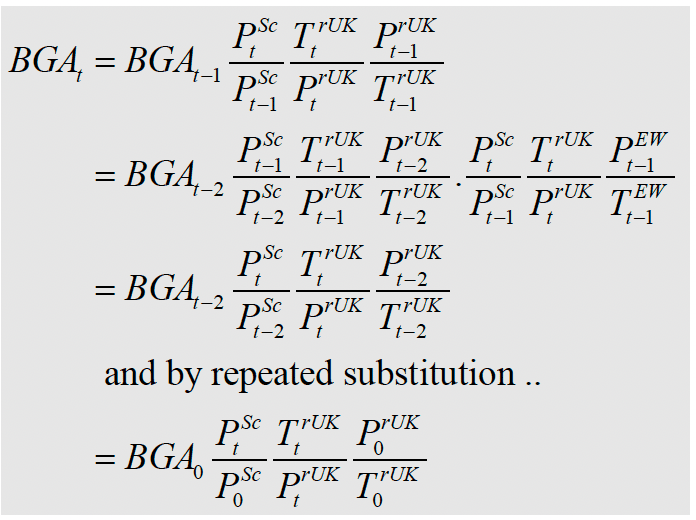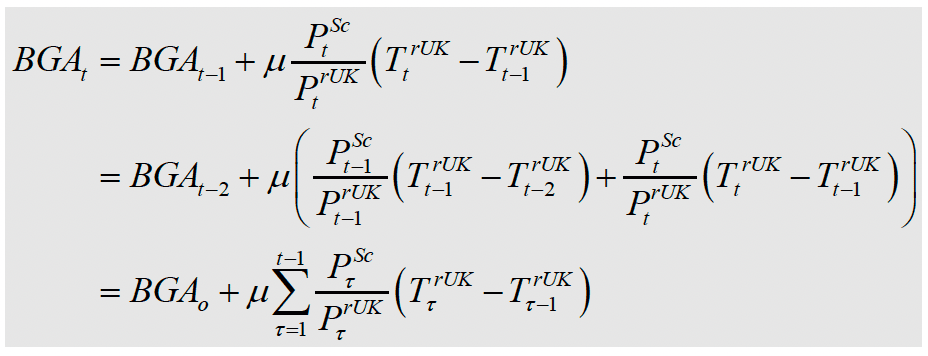Fiscal Framework Review: Independent Report
An independent report to consider the Block Grant Adjustment arrangements commissioned by Scottish Government and HM Treasury in June 2022, written by Professor David Bell (University of Stirling), David Eiser (formerly University of Strathclyde) and David Phillips (Institute for Fiscal Studies).
Appendix C: The Maths of BGA
In this appendix, we demonstrate some of the mathematical properties of the BGA methods. We particularly contrast how the IPC and CM/Barnett Formula BGAs adjust to an economic cycle, where revenues or social security spending in that part of the UK used as the comparator initially rise or fall before returning to their initial value. We thus compare the BGA in period 0 with that in period t (an arbitrary time in the future at the end of an economic cycle).
In the equations that followg  represents the value of the BGA at time t.
represents the value of the BGA at time t.  and
and  are the populations of Scotland and the rest of UK (see Table 1 for the relevant geographical extent for each fiscal instrument) at time t.
are the populations of Scotland and the rest of UK (see Table 1 for the relevant geographical extent for each fiscal instrument) at time t.  is the tax revenue or social security spending at time t in the relevant geographical extent.. Using these conventions, we can write the IPC method as shown in equation (1) below.
is the tax revenue or social security spending at time t in the relevant geographical extent.. Using these conventions, we can write the IPC method as shown in equation (1) below.
The Indexed Per Capita Method
(1)

After t periods, the IPC BGA depends solely on its initial value, the growth in Scottish population since the initial period, and the change in per capita revenue/spending in the comparator part of the UK since the initial period.
Equation 2, which follows from Equation 1, shows the relationship between the initial period BGA and that in period t if tax revenue/social security spending returns to its initial value.
(2)

The IPC BGA depends only on its initial value and the relative growth of Scotland's population since the first period which can also be interpreted as the ratio of Scotland's population to that of the comparator part of the UK. The final BGA is equal to its initial value multiplied by the relative growth in population since the first period in Scotland versus the comparator part of the UK. If that growth is held constant at its initial value, the final BGA value is equal to its initial value multiplied by the initial period relative population growth rates. Scotland is completely insured against slower population growth with the IPC method during an economic cycle in which comparator tax revenues/social security spending return to their initial value.
The Comparable Method
With the Comparable Method, the BGA equals last period value plus Scotland's population share of the change in equivalent revenues in the rUK, adjusted by the comparability factor, which adjusts for the difference between the amount of tax raised per head in Scotland, relative to that in the rUK. Successively substitution for lagged value gives the expression shown in (3), which implies that the BGA in time period t is equal to its initial value plus the sum of the annual changes in revenues in England and Wales multiplied by Scotland's population share at that time and all multiplied by the comparability factor.
(3)

Suppose that revenues return to their initial value after an economic cycle and that Scotland's population share remains constant, taking the value θ. Then (4) follows from (3) and shows that the CM BGA will return to its original value if revenues return to their initial vale and the population share remains constant. The same argument applies to the Barnett Formula, which takes the same form as the CM, except that the comparability factor is set equal to 1.
(4)

Thus, an increase in social security spending in the rUK followed by a return to the initial level will result in the Barnett BGA also returning to its initial value if Scotland's population share remains constant. If it declines, then from (3) the effect on the BGA will depend on the timing of changes in population share in relation to the positive and negative movements in spending in the rUK. If, for example, the decline in population share takes place only in the last period when, by definition, spending in the rUK is falling, then the smaller population share is only applied once, and hence the positive increments to the BGA as spending rises will outweigh the offsetting effects as it falls, leading to an outcome where the BGA in period t exceeds its initial value.
Contact
Email: matthew.elsby@gov.scot
There is a problem
Thanks for your feedback